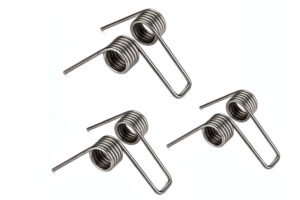Understanding Torsion Spring Force: Key Factors and Applications

Torsion springs are mechanical devices that store and release rotational energy when subjected to a twisting or torsional force. These springs find applications in various industries, including automotive, aerospace, manufacturing, and construction. This article aims to provide a comprehensive understanding of torsion spring force, exploring key factors that influence it and highlighting its significance in different applications.
1. The Basics of Torsion Spring Force:
Torsion spring force refers to the amount of torque or rotational force required to twist or deform the spring. This force is directly proportional to the spring’s stiffness or spring rate, which is determined by the material properties, wire diameter, coil diameter, and the number of coils. A higher spring rate indicates a stiffer spring that requires more force to twist, while a lower spring rate indicates a more flexible spring.
2. Factors Influencing Torsion Spring Force:
a) Material Selection: The choice of material significantly influences the torsion spring force. Commonly used materials include stainless steel, carbon steel, alloy steel, and various non-ferrous alloys. Each material has its unique properties, such as elasticity, tensile strength, and durability, which affect the spring’s force and performance.
b) Wire Diameter: The wire diameter determines the cross-sectional area of the spring, directly impacting its strength and stiffness. Thicker wire diameters result in a higher torsion force, while thinner wires provide lower force but increased flexibility.
c) Coil Diameter and Number of Coils: The coil diameter and the number of coils play a critical role in determining the spring’s force and deflection characteristics. Larger coil diameters and longer lengths result in a lower torsion spring force, while smaller coil diameters and shorter lengths offer higher force but reduced deflection capabilities.
3. Calculating :
To determine the torsion spring force, engineers use Hooke’s Law, which states that the force exerted is proportional to the amount of deformation or twisting. The formula to calculate torsion spring force is F = k * θ, where F represents the force, k is the spring constant or spring rate, and θ is the angle of twist or deflection in radians. This formula enables engineers to calculate the force required to achieve a specific angle of twist.
4. Applications :
Torsion springs find a wide range of applications in various industries, including:
a) Automotive: They are used in suspension systems, door handles, trunk lids, and various mechanical components that require rotational force.
b) Aerospace: Theyare vital in aircraft control systems, landing gear mechanisms, and engine assemblies, where precise force and deflection characteristics are crucial.
c) Manufacturing: They are utilized in machinery, equipment, and tools that require rotational force, such as clamps, torque wrenches, and hinges.
d) Construction: Torsion springs are employed in doors, windows, garage doors, and gates to provide controlled rotational movement and counterbalance.
5. Considerations for Torsion Spring Design:
When designing with springs, it is essential to consider factors such as stress levels, fatigue life, deflection limits, and operating environments. Working with experienced spring manufacturers or consulting spring design resources can help ensure optimal design and performance.
Conclusion:
Understanding torsion spring force is crucial for selecting the right spring for a particular application. Factors such as material selection, wire diameter, coil diameter, and the number of coils significantly influence the force and deflection characteristics of torsion springs. By considering these factors and utilizing appropriate calculation methods, engineers can design torsion springs that meet the specific torque requirements for various applications. This knowledge facilitates efficient and reliable performance in automotive, aerospace, manufacturing, and construction industries, among others.






